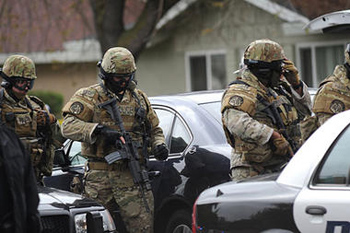
Modesto police officers prepare to enter the scene of a shooting on Thursday in Modesto, Calif. A sheriff's deputy and a civilian were killed when gunfire broke out as authorities tried to serve an eviction notice at an apartment complex, officials said. (Joan Barnett Lee/The Modesto Bee/AP)
Two high-profile shootings of police officers in small towns - one on each coast - are highlighting statistics that show a sharp spike in police officer deaths nationwide during the past two years.
But experts caution against the conclusion that criminals are ramping up a new "war on cops," instead suggesting that the statistics merely show an end to a 40-year decline in officer fatalities.
Killed Thursday in Greenland, N.H., was Chief Michael Maloney, one week short of retirement; four other officers were shot. Also on Thursday in Modesto, Calif., a civilian and a sheriff's deputy were shot and killed by a homeowner who opened fire to avoid being evicted by authorities.
Last year, 72 officers were killed in the line of duty, up from 41 in 2008. But the 2011 number is similar to 2001, when 70 officers were killed - and it is far below the statistics from the 1970s. In 1973, for example, 143 officer deaths were reported.
"Newton's law of criminology states that what goes down must eventually go up," says James Alan Fox, a criminologist at Northeastern University in Boston. "After that long a decline, it's not surprising at all that the number has finally jumped."
While other analysts agree, they add that Thursday's shootings highlight other areas of concern.
For instance, the number of assaults against police officers, has reached more than 50,000 per year, "and we think that is underreported. The FBI thinks that's only half the number," says John Firman, director of research for the International Association of Chiefs of Police in Alexandria, Va.
His organization last year opened the Center for Prevention of Violence Against Police, funded by the US Department of Justice. "We are taking an aggressive position against this kind of backlash against police in which a bad guy thinks he can just start shooting," he says. "We are out to change the police practices and protocols to deal with it."
Part of the problem is the so-called war on drugs, suggests Neill Franklin, executive director of Law Enforcement Against Prohibition, which favors legalizing and regulating drugs. The drug war has led to a huge deterioration in the relations between police and the community, with police departments becoming more likely to use SWAT teams, whether necessary or not, he says. That has heightened the tension of drug busts needlessly.
"Law enforcement changed its policies because they got all these government grants to obtain paramilitary equipment and then felt compelled to use it all the time, even just to serve a warrant," says Mr. Franklin. "It has led to lots of unnecessary violence."
In some ways, the growing number of officer deaths is surprising, given that more police officers are wearing bulletproof Kevlar vests and medical treatments have improved, says Joel Jacobsen, assistant attorney general, criminal appeals division for New Mexico, in an e-mail.
"Both of those trends should be dramatically reducing the number of fatalities," he says. "So the fact that the number remains roughly the same actually suggests an increase in the use of potentially-lethal force against officers.
One solution might be new protocols for how to serve warrants, says former Maryland police officer Tod Burke, now professor of criminal justice at Radford University in Virginia, in an e-mail.
"While these incidents are on the rise, they are not new. Police officers have been attacked/shot at for years while serving arrest and search warrants, apprehending suspects in a home, etc.," he says. "While tragic, sometimes an orange is simply an orange. This may be a matter of police policy and revisiting officer safety issues while serving warrants."











